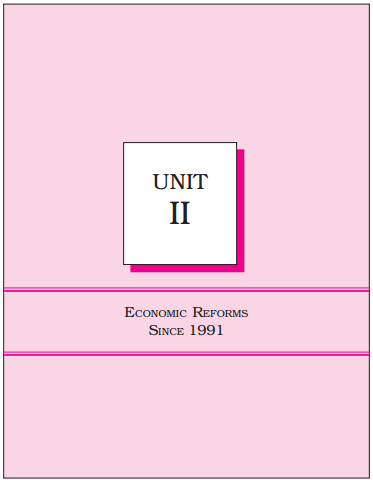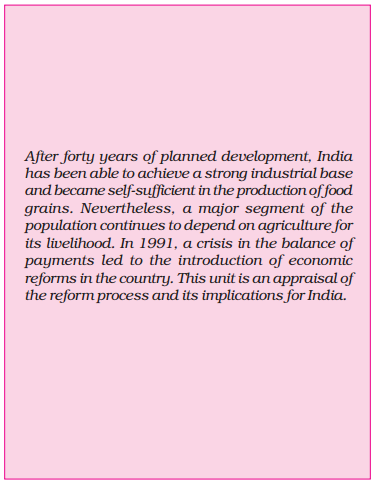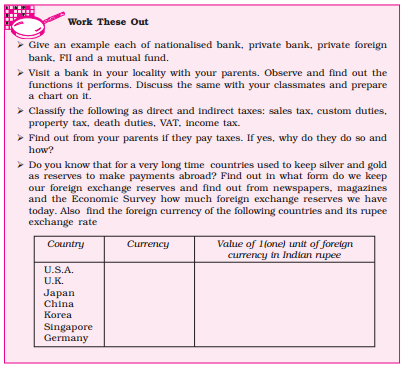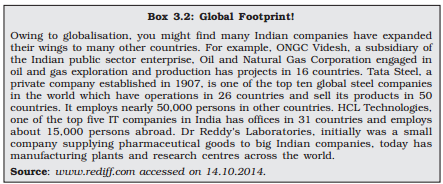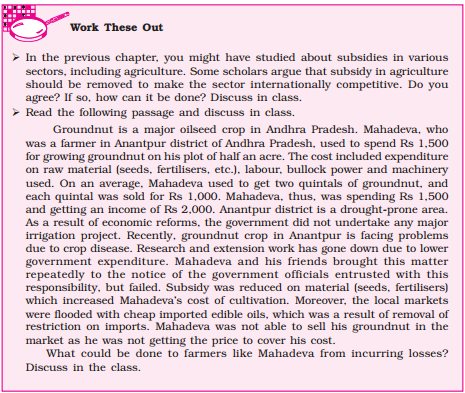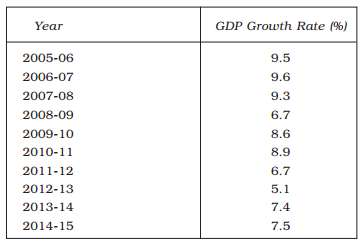Table of Contents
3
LIBERALISATION, PRIVATISATION AND GLOBALISATION: AN APPRAISAL
After studying this chapter, the learners will
• understand the background of the reform policies introduced in India in 1991
• understand the mechanism through which reform policies were introduced
• comprehend the process of globalisation and its implications for India
• be aware of the impact of the reform process in various sectors.
There is a consensus in the world today that economic development is not all and the GDP is not necessarily a measure of progress of a society.
3.1 INTRODUCTION
You have studied in the previous chapter that, since independence, India followed the mixed economy framework by combining the advantages of the capitalist economic system with those of the socialist economic system. Some scholars argue that, over the years, this policy resulted in the establishment of a variety of rules and laws, which were aimed at controlling and regulating the economy, ended up instead in
hampering the process of growth and development. Others state that India, which started its developmental path from near stagnation, has since been able to achieve growth in savings, developed a diversified industrial sector which produces a variety of goods and has experienced sustained expansion of agricultural output which has ensured food security.
In 1991, India met with an economic crisis relating to its external debt — the government was not
able to make repayments on its borrowings from abroad; foreign exchange reserves, which we generally maintain to import petrol and other important items, dropped to levels that were not sufficient for even a fortnight. The crisis was further compounded by rising prices of essential goods. All these led the government to introduce a new set of policy measures which changed the direction of our developmental strategies. In this chapter, we will look at the background of the crisis, measures that the government has adopted and their impact on various sectors of the economy.
3.2 Background
The origin of the financial crisis can be traced from the inefficient management of the Indian economy in the 1980s. We know that for implementing various policies and
its general administration, the government generates funds from various sources such as taxation, running of public sector enterprises etc. When expenditure is more than income, the government borrows to finance the deficit from banks and also from people within the country and from international financial institutions. When we import goods like petroleum, we pay in dollars which we earn from our exports.
Development policies required that even though the revenues were
very low, the government had
to overshoot its revenue to meet challenges like unemployment, poverty and population explosion. The continued spending on development programmes of the government did not generate additional revenue. Moreover, the government was not able to generate sufficiently from internal sources such as taxation. When the government was spending a large share of its income on areas which do not provide immediate returns such as the social sector and defence, there was a need to utilise the rest of its revenue in a highly efficient manner. The income from public sector undertakings was also not very high to meet the growing expenditure. At times, our foreign exchange, borrowed from other countries and international financial institutions, was spent on meeting consumption needs. Neither was an attempt made to reduce such profligate spending nor sufficient attention was given to boost exports to pay for the growing imports.
In the late 1980s, government expenditure began to exceed its revenue by such large margins that meeting the expenditure through borrowings became unsustainable. Prices of many essential goods rose sharply. Imports grew at a very high rate without matching growth of exports. As pointed out earlier, foreign exchange reserves declined to a level that was not adequate to finance imports for more than two weeks. There was also not sufficient foreign exchange to pay the interest that needs to be paid to international lenders. Also no country or international funder was willing to lend to India.
India approached the International Bank for Reconstruction and Development (IBRD), popularly known as World Bank and the International Monetary Fund (IMF), and received $7 billion as loan to manage the crisis. For availing the loan, these international agencies expected India to liberalise and open up the economy by removing restrictions on the private sector, reduce the role of the government in many areas and remove trade restrictions between India and other countries.
India agreed to the conditionalities of World Bank and IMF and announced the New Economic Policy (NEP). The NEP consisted of wide ranging economic reforms. The thrust of the policies was towards creating a more competitive environment in the economy and removing the barriers to entry and growth of firms. This set of policies can broadly be classified into two groups: the stabilisation measures and the structural reform measures. Stabilisation measures are short-term measures, intended to correct some of the weaknesses that have developed in the balance of payments and to bring inflation under control. In simple words, this means that there was a need to maintain sufficient foreign exchange reserves and keep the rising prices under control. On the other hand, structural reform policies are long-term measures, aimed at improving the efficiency of the economy and increasing its international competitiveness by removing the rigidities in various segments of the Indian economy. The government initiated a variety of policies which fall under three heads viz., liberalisation, privatisation and globalisation.
3.3 Liberalisation
As pointed out in the beginning, rules and laws which were aimed at regulating the economic activities became major hindrances in growth and development. Liberalisation was introduced to put an end to these restrictions and open various sectors of the economy. Though a few liberalisation measures were introduced in 1980s in areas of industrial licensing, export-import policy, technology upgradation, fiscal policy and foreign investment, reform policies initiated in 1991 were more comprehensive. Let us study some important areas, such as the industrial sector, financial sector, tax reforms, foreign exchange markets and trade and investment sectors which received greater attention in and after 1991.
Deregulation of Industrial Sector: In India, regulatory mechanisms were enforced in various ways (i) industrial licensing under which every entrepreneur had to get permission from government officials to start a firm, close a firm
or decide the amount of goods
that could be produced (ii) private sector was not allowed in many industries (iii) some goods could be produced only in small-scale industries, and (iv) controls on price fixation and distribution of selected industrial products.
The reform policies introduced in and after 1991 removed many of these restrictions. Industrial licensing was abolished for almost all but product categories — alcohol, cigarettes, hazardous chemicals, industrial explosives, electronics, aerospace and drugs and pharma-ceuticals. The only industries which are now reserved for the public sector are a part of defence equipment, atomic energy generation and railway transport. Many goods produced by small-scale industries have now been dereserved. In many industries, the market has been allowed to determine the prices.
Financial Sector Reforms: Financial sector includes financial institutions, such as commercial banks, investment banks, stock exchange operations and foreign exchange market. The financial sector in India is regulated by the Reserve Bank of India (RBI). You may be aware that all banks and other financial institutions in India are regulated through various norms and regulations of the RBI. The RBI decides the amount of money that the banks can keep with themselves, fixes interest rates, nature of lending to various sectors, etc. One of the major aims of financial sector reforms is to reduce the role of RBI from regulator to facilitator of financial sector. This means that the financial sector may be allowed to take decisions on many matters without consulting the RBI.
The reform policies led to the establishment of private sector banks, Indian as well as foreign. Foreign investment limit in banks was raised to around 50 per cent. Those banks which fulfil certain conditions have been given freedom to set up new branches without the approval of the RBI and rationalise their existing branch networks. Though banks have been given permission to generate resources from India and abroad, certain managerial aspects have been retained with the RBI to safeguard the interests of the account-holders and the nation. Foreign Institutional Investors (FII), such as merchant bankers, mutual funds and pension funds, are now allowed to invest in Indian financial markets.
Tax Reforms: Tax reforms are concerned with the reforms in the government’s taxation and public expenditure policies, which are collectively known as its fiscal policy. There are two types of taxes: direct and indirect. Direct taxes consist of taxes on incomes of individuals, as well as, profits of business enterprises. Since 1991, there has been a continuous reduction in the taxes on individual incomes as it was felt that high rates of income tax were an important reason for tax evasion. It is now widely accepted that moderate rates of income tax encourage savings and voluntary disclosure of income. The rate of corporation tax, which was very high earlier, has been gradually reduced. Efforts have also been made to reform the indirect taxes, taxes levied on commodities, in order to facilitate the establishment of a common national market for goods and commodities. Another component of reforms in this area is simplification. In order to encourage better compliance on the part of taxpayers many procedures have been simplified and the rates also substantially lowered. Recently, the Parliament passed a law, Goods and Services Tax Act 2016, to simplify and introduce a unified indirect tax system in India. This law came into effect from July 2017. This is expected to generate additional revenue for the government, reduce tax evasion and create ‘one nation, one tax and one market’.
Foreign Exchange Reforms: The first important reform in the external sector was made in the foreign exchange market. In 1991, as an immediate measure to resolve the balance of payments crisis, the rupee was devalued against foreign currencies. This led to an increase in the inflow of foreign exchange. It also set the tone to free the determination of rupee value in the foreign exchange market from government control. Now, more often than not, markets determine exchange rates based on the demand and supply of foreign exchange.
Trade and Investment Policy Reforms: Liberalisation of trade and investment regime was initiated to increase international competitiveness of industrial production and also foreign investments and technology into the economy. The aim was also to promote the efficiency of local industries and adoption of modern technologies.
In order to protect domestic industries, India was following a regime of quantitative restrictions on imports. This was encouraged through tight control over imports and by keeping the tariffs very high. These policies reduced efficiency and competitiveness which led to slow growth of the manufacturing sector. The trade policy reforms aimed at (i) dismantling of quantitative restrictions on imports and exports (ii) reduction of tariff rates and (iii) removal of licensing procedures for imports. Import licensing was abolished except in case of hazardous and environmentally sensitive industries. Quantitative restrictions on imports of manufactured consumer goods and agricultural products were also fully removed from April 2001. Export duties have been removed to increase the competitive position of Indian goods in the international markets.
3.4 Privatisation
It implies shedding of the ownership or management of a government owned enterprise. Government companies are converted into private companies in two ways (i) by withdrawal of the government from ownership and management of public sector companies and or (ii) by outright sale of public sector companies.
Privatisation of the public sector enterprises by selling off part of the equity of PSEs to the public is known as disinvestment. The purpose of the sale, according to the government,
was mainly to improve financial discipline and facilitate modernisation. It was also envisaged that private capital and managerial capabilities could be effectively utilised to
improve the performance of the PSUs. The government envisaged that privatisation could provide strong impetus to the inflow of FDI.
Box 3.1: Navratnas and Public Enterprise Policies
You must have read in your childhood about the famous Navratnas or Nine Jewels in the Imperial Court of King Vikramaditya who were eminent persons of excellence in the fields of art, literature and knowledge. In order to improve efficiency, infuse professionalism and enable them to compete more effectively in the liberalised global environment, the government identifies PSEs and declare them as maharatnas, navratnas and miniratnas. They were given greater managerial and operational autonomy, in taking various decisions to run the company efficiently and thus increase their profits. Greater operational, financial and managerial autonomy has also been granted to profit-making enterprises referred to as miniratnas.
The Central Public Sector Enterprises are designated with different status.
A few examples of public enterprises with their status are as follows: (i) Maharatnas – (a) Indian Oil Corporation Limited, and (b) Steel Authority of India Limited, (ii) Navratnas – (a) Hindustan Aeronautics Limited, (b) Mahanagar Telephone Nigam Limited; and (iii) Miniratnas – (a) Bharat Sanchar Nigam Limited; (b) Airport Authority of India and (c) Indian Railway Catering and Tourism Corporation Limited.
Many of these profitable PSEs were originally formed during the 1950s and 1960s when self-reliance was an important element of public policy. They were set up with the intention of providing infrastructure and direct employment to the public so that quality end-product reaches the masses at a nominal cost and the companies themselves were made accountable to all stakeholders.
The granting of status resulted in better performance of these companies. Scholars allege that instead of facilitating public enterprises in their expansion and enabling them to become global players, the government partly privatised them through disinvesment. Of late, the government has decided to retain them in the public sector and enable them to expand themselves in the global markets and raise resources by themselves from financial markets.
3.5 Globalisation
Although globalisation is generally understood to mean integration of the economy of the country with the world economy, it is a complex phenomenon. It is an outcome of the set of various policies that are aimed at transforming the world towards greater interdependence and integration. It involves creation of networks and activities transcending economic, social and geographical boundaries. Globalisation attempts to establish links in such a way that the happenings in India can be influenced by events happening miles away. It is turning the world into one whole or creating a borderless world.
Outsourcing: This is one of the important outcomes of the globalisation process. In outsourcing, a company hires regular service from external sources, mostly from other countries, which was previously provided internally or from within the country (like legal advice, computer service, advertisement, security — each provided by respective departments of the company). As a form of economic activity, outsourcing has intensified, in recent times, because of the growth of fast modes of communication, particularly the growth of Information Technology (IT). Many of the services such as voice-based business processes (popularly known as BPO or
call centres), record keeping, accountancy, banking services, music recording, film editing, book transcription, clinical advice or even teaching are being outsourced by companies in developed countries to India. With the help of modern telecommunication links including the Internet, the text, voice and visual data in respect of these services is digitised and transmitted in real time over continents and national boundaries.
Most multinational corporations, and even small companies, are outsourcing their services to India where they can be availed at a cheaper cost with reasonable degree of skill and accuracy. The low wage rates and availability of skilled manpower in India have made it a destination for global outsourcing in the post-reform period.
World Trade Organisation (WTO): The WTO was founded in 1995 as
the successor organisation to the
General Agreement on Trade and
Tariff (GATT). GATT was established
in 1948 with 23 countries as the
global trade organisation to administer all multilateral trade agreements by providing equal opportunities to
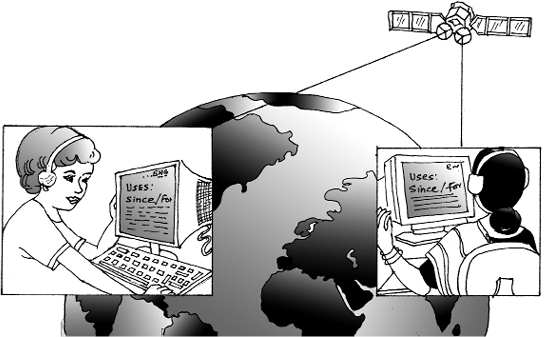 all countries in the international market for trading purposes. WTO is expected to establish a rule-based trading regime in which nations cannot place arbitrary restrictions on trade. In addition, its purpose is also to enlarge production and trade of services, to ensure optimum utilisation of world resources and to protect the environment. The WTO agreements cover trade in goods as well as services to facilitate international trade (bilateral and multilateral) through removal of tariff as well as non-tariff barriers and providing greater market access to all member countries.
all countries in the international market for trading purposes. WTO is expected to establish a rule-based trading regime in which nations cannot place arbitrary restrictions on trade. In addition, its purpose is also to enlarge production and trade of services, to ensure optimum utilisation of world resources and to protect the environment. The WTO agreements cover trade in goods as well as services to facilitate international trade (bilateral and multilateral) through removal of tariff as well as non-tariff barriers and providing greater market access to all member countries.
As an important member of WTO, India has been in the forefront of framing fair global rules, regulations and safeguards and advocating the interests of the developing world. India has kept its commitments towards liberalisation of trade, made in the WTO, by removing quantitative restrictions on imports and reducing tariff rates.

Some scholars question the usefulness of India being a member of the WTO as a major volume of international trade occurs among the developed nations. They also say that while developed countries file complaints over agricultural subsidies given in their countries, developing countries feel cheated as they are forced to open their markets for developed countries but are not allowed access to the markets of developed countries. What do you think?
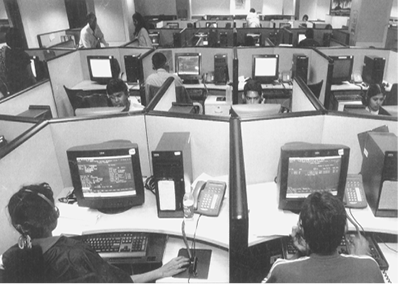
Fig. 3.2 IT industry is seen as a major contributor to India’s exports
3.6 Indian Economy During Reforms: an Assessment
The reform process has completed one- and-a-half decades since its introduction. Let us now look at the performance of the Indian economy during this period. In economics, the growth of an economy is measured by the Gross Domestic Product. Look at Table 3.1. The post–1991 India witnessed a rapid growth in GDP on a continual basis for two decades. The growth of GDP increased from 5.6 per cent during 1980–91 to 8.2 per cent during 2007–12. During the reform period, the growth of agriculture has declined. While the industrial sector reported fluctuation, the growth of the service sector has gone up. This indicates that this growth is mainly driven by growth in the service sector. During 2012-15, there has been a setback in the growth rates of different sectors witnessed post–1991. While agriculture recorded a high growth rate during 2013–14, this sector witnessed negative growth in the subsequent year. While the service sector continued to witness a high level of growth — higher than the overall GDP growth in 2014–15, this sector witnessed the highest-ever growth rate of 10.3 per cent. The industrial sector witnessed a steep decline during 2012–13, it began to show a continuous positive growth.
Fig. 3.1 Outsourcing: a new employment opportunity in big cities
The opening of the economy has led to a rapid increase in foreign direct investment and foreign exchange reserves. The foreign investment,
which includes foreign direct investment (FDI) and foreign institutional investment (FII), has increased from about US $100 million in 1990-91 to US $ 36 billion in
2016-17. There has been an increase in the foreign exchange reserves from about US $ 6 billion in 1990-91 to about US $ 321 billion in 2014-15. India is one of the largest foreign exchange reserve holders in the world.
India is seen as a successful exporter of auto parts, engineering goods, IT software and textiles in the reform period. Rising prices have also been kept under control.
On the other hand, the reform process has been widely criticised
for not being able to address some
of the basic problems facing our economy especially in areas of employment, agriculture, industry, infrastructure development and fiscal management.
Growth and Employment: Though the GDP growth rate has increased in the reform period, scholars point out that the reform-led growth has not generated sufficient employment opportunities in the country. You will study the link between different aspects of employment and growth in the next unit.
Reforms in Agriculture: Reforms have not been able to benefit agriculture, where the growth rate has been decelerating.
Public investment in agriculture sector especially in infrastructure, which includes irrigation, power, roads, market linkages and research and extension (which played a crucial role in the Green Revolution), has fallen in the reform period. Further, the removal of fertiliser subsidy has led to increase in the cost of production, which has severely affected the small and marginal farmers. This sector has been experiencing a number of policy changes such as reduction in import duties on agricultural products, removal of minimum support price and lifting of quantitative restrictions on agricultural products; these have adversely affected Indian farmers as they now have to face increased international competition.
Moreover, because of export- oriented policy strategies in agriculture, there has been a shift from production for the domestic market towards production for the export market focusing on cash crops in lieu of production of food grains. This puts pressure on prices of food grains.
Reforms in Industry: Industrial growth has also recorded a slowdown. This is because of decreasing demand of industrial products due to
various reasons such as cheaper
imports, inadequate investment in infrastructure etc. In a globalised world, developing countries are compelled to open up their economies to greater flow of goods and capital
from developed countries and
rendering their industries vulnerable to imported goods. Cheaper imports
have, thus, replaced the demand
for domestic goods. Domestic manufacturers are facing competition from imports. The infrastructure facilities, including power supply, have remained inadequate due to lack of investment. Globalisation is, thus, often seen as creating conditions for the free movement of goods and services from foreign countries that adversely affect the local industries and employment opportunities in developing countries.
Moreover, a developing country like India still does not have the access to developed countries’ markets because of high non-tariff barriers. For example, although all quota restrictions on exports of textiles and clothing have been removed in India, USA has not removed their quota restriction on import of textiles from India and China.
Disinvestment: Every year, the government fixes a target for disinvestment of PSEs. For instance, in 1991-92, it was targeted to mobilise Rs 2500 crore through disinvestment. The government was able to mobilise ` 3,040 crore more than the target. In 2017–18, the target was about
`1,00,000 crore, whereas, the achievement was about ` 1,00,057 crore. Critics point out that the assets of PSEs have been undervalued and sold to the private sector. This means that there has been a substantial loss to the government. Moreover, the proceeds from disinvestment were used to offset the shortage of government revenues rather than using it for the development of PSEs and building social infrastructure in the country. Do you think selling a part of the properties of government companies is the best way to improve their efficiency?
Reforms and Fiscal Policies: Economic reforms have placed limits on the growth of public expenditure, especially in social sectors. The tax reductions in the reform period, aimed at yielding larger revenue and curb tax evasion, have not resulted in increase in tax revenue for the government. Also, the reform policies, involving tariff reduction, have curtailed the scope for raising revenue through custom duties. In order to attract foreign investment, tax incentives were provided to foreign investors which further reduced the scope for raising tax revenues. This has a negative impact on developmental and welfare expenditures.
3.7 Conclusion
The process of globalisation through liberalisation and privatisation policies has produced positive, as well as, negative results both for India and other countries. Some scholars argue that globalisation should be seen as an opportunity in terms of greater access to global markets, high technology and increased possibility of large industries of developing countries to become important players in the international arena.
Box 3.3: Siricilla Tragedy!
Power sector reforms in many Indian states led to do away with the supply of electricity at subsidised rates and steep rise in power tariff. This has affected workers engaged in small industries. Powerloom textile industry in Andhra Pradesh is an example. Since the wages of the powerloom workers are linked to the production of cloth, power cut means cut in wages of weavers, who were already suffering from hike in tariff. This led to a crisis in the livelihood of the weavers and 50 powerloom workers committed suicide in a small town called ‘Siricilla’ in Andhra Pradesh.
Ø Do you think the power tariff should not be raised?
Ø What would be your suggestions to revive small industries affected by reforms?
On the contrary, the critics argue that globalisation is a strategy of the developed countries to expand their markets in other countries. According to them, it has compromised the welfare and identity of people belonging to poor countries. It has further been pointed out that market-driven globalisation has widened the economic disparities among nations and people.
Viewed from the Indian context, some studies have stated that the crisis that erupted in the early 1990s was basically an outcome of the deep-rooted inequalities in Indian society and the economic reform policies initiated as a response to the crisis by the government, with externally advised policy package, further aggravated the inequalities. Further, it has increased the income and quality of consumption of only high-income groups and the growth has been concentrated only in
some select areas in the services sector such as telecommunication, information technology, finance, entertainment, travel and hospitality services, real estate and trade,
rather than vital sectors such as agriculture and industry which provide livelihoods to millions of people in the country.
Recap
The economy was facing problems of declining foreign exchange, growing imports without matching rise in exports and high inflation. India changed its economic policies in 1991 due to a financial crisis and pressure from international organisations like the World Bank and IMF.
Ø In the domestic economy, major reforms were undertaken in the industrial and financial sectors. Major external sector reforms included foreign exchange deregulations and import liberalisation.
Ø With a view to improving the performance of the public sector, there was a consensus on reducing its role and opening it up to the private sector. This was done through disinvestment and liberalisation measures.
Ø Globalisation is the outcome of the policies of liberalisation and privatisation. It means an integration of the economy of the country with the world economy.
Ø Outsourcing is an emerging business activity.
Ø The objective of the WTO is to establish a rule based trade regime to ensure optimum utilisation of world resources.
Ø During the reforms, growth of agriculture and industry has gone down but the service sector has registered growth.
Ø Reforms have not benefited the agriculture sector. There has also been a decline in public investment in this sector.
Ø Industrial sector growth has slowed down due to availability of cheaper imports and lower investment.
EXERCISE
2. Why is it necessary to became a member of WTO?
3. Why did RBI have to change its role from controller to facilitator of financial sector in India?
4. How is RBI controlling the commercial banks?
5. What do you understand by devaluation of rupee?
6. Distinguish between the following
(i) Strategic and Minority sale
(ii) Bilateral and Multi-lateral trade
(iii) Tariff and Non-tariff barriers.
7. Why are tariffs imposed?
8. What is the meaning of quantitative restrictions?
9. Those public sector undertakings which are making profits should be privatised. Do you agree with this view? Why?
10. Do you think outsourcing is good for India? Why are developed countries opposing it?
11. India has certain advantages which makes it a favourite outsourcing destination. What are these advantages?
12. Do you think the navaratna policy of the government helps in improving the performance of public sector undertakings in India? How?
13. What are the major factors responsible for the high growth of the service sector?
14. Agriculture sector appears to be adversely affected by the reform process. Why?
15. Why has the industrial sector performed poorly in the reform
period?
16. Discuss economic reforms in India in the light of social justice and welfare.
 1. The table given below shows the GDP growth rate at 2004-05 prices. You have studied about the techniques of presentation
1. The table given below shows the GDP growth rate at 2004-05 prices. You have studied about the techniques of presentation of data in your Statistics for Economics course. Draw a time
series line graph based on the data given in the table and interpret the same.
2. Observe around you — you will find State Electricity Boards (SEBs), BSES and many public and private organisations supplying electricity in a city and states. There are private buses on roads along side the goverment bus services and so on
(i) What do you think about this dual system of the co-existence of public and private sectors?
(ii) What are the merits and demerits of such a dual system? Discuss.
3. With the help of your parents and grandparents prepare a list of multinational companies that existed in India at the time of independence. Now put a () mark against those which are still growing and a (×) against those which do not exist any more. Are there any companies whose names have changed? Find out the new names, the country of origin, nature of product, logo and prepare a chart for your class.
4. Give appropriate examples for the following

Now find out if these companies which are mentioned above existed in India before 1991 or came after the New Economic Policy. For this, take the help of your teacher, parents, grandparents and shopkeepers.
5. Collect a few relevant newspaper cuttings on meetings organised by WTO. Discuss the issues debated in these meetings and find out how the organisation facilitates world trade.
6. Was it necessary for India to introduce economic reforms at the behest of World Bank and International Monetary Fund? Was there no alternative for the government to solve the balance of payments crisis? Discuss in the classroom.
 Books
Books
Acharya, S. 2003. India’s Economy: Some Issues and Answers. Academic Foundation, New Delhi.
Alternative Survey Group. 2005. Alternative Economic Survey, India 2004–05, Disequalising Growth. Daanish Books, Delhi.
Ahluwalia, I.J. and I.M.D. Little. 1998. India’s Economic Reforms and Development. Oxford University Press, New Delhi.
Bardhan, Pranab. 1998. The Political Economy of Development in India. Oxford University Press, Delhi.
Bhaduri, Amit and Deepak Nayyar. 1996. The Intelligent Person’s Guide to Liberalisation. Penguin, Delhi.
Bhagwati, Jagdish. 1992. India in Transition: Freeing the Economy. Oxford University Press, Delhi.
Byres, Terence J. 1997. The State, Development Planning and Liberalisation in India. Oxford University Press, Delhi.
Chadha, G.K. 1994. Policy Perspectives in Indian Economic Development. Har-Anand, Delhi.
Chelliah, Raja J. 1996. Towards Sustainable Growth: Essays in Fiscal and Financial Sector Reforms in India. Oxford University Press, New Delhi.
Debroy, B. and Rahul Mukherji (Eds.). 2004. The Political Economy of Reforms. Bookwell Publication, New Delhi.
Dreze, Jean and Amartya Sen. 1996. India: Economic Development and Social Opportunity. Oxford University Press, New Delhi.
Dutt, Ruddar and K.P.M. Sundaram. 2005. Indian Economy. S. Chand and Company, New Delhi.
Guha, Ashok (Ed.) 1990. Economic Liberalisation, Industrial Structure and Growth in India. Oxford University Press, New Delhi.
Jalan, Bimal. 1993. India’s Economic Crisis: The Way Ahead. Oxford
University Press, New Delhi.
Jalan, Bimal. 1996. India’s Economic Policy: Preparing for the Twenty First Century. Viking, Delhi.
Joshi, Vijay and I.M.D. Little. 1996. India’s Economic Reforms 1991-2001. Oxford University Press, New Delhi,
Kapila, Uma. 2005. Understanding the Problems of Indian Economy. Academic Foundation, New Delhi.
Mahajan, V.S. 1994. Indian Economy Towards 2000 A.D. Deep & Deep, Delhi.
Parekh, Kirit and Radhakrishna, 2002, India Development Report 2001-02. Oxford University Press, New Delhi.
Rao, C.H. Hanumantha. and Hans Linnemann. 1996. Economic Reforms and Poverty Alleviation in India, Sage Publication, Delhi.
Sachs, Jeffrey D., Ashutosh Varshney and Nirupam Bajpai.1999. India in the Era of Economic Reforms. Oxford University Press, New Delhi.
Government Reports and Websites
Economic Survey for various years. Ministry of Finance, Government of India. Published by Oxford University Press, New Delhi.
Tenth Five Year Plan 1997-2002. Vol. 1. Government of India, Planning Commission, New Delhi.
(Niti Aayog) Appraisal Document of Twelfth Five Year Plan 2012-2017, Government of India.
https://dipam.gov.in

